"Top secret: water plus oxygen ..." Part I. Sharks of Admiral Doenitz
But before proceeding to the main part, the author would like to clarify two points. The first is the title of the article. There were a lot of options, but in the end it was decided to use the title of one of the publications written by engineer-captain of the second rank L.S. Shapiro, as the most clearly meet not only the content, but also the circumstances that accompanied the introduction of hydrogen peroxide into military practice.
The second is why the author was interested in this particular substance? Or rather - what exactly did it interest him? Oddly enough, its completely paradoxical fate in the military arena. The fact is that hydrogen peroxide has a whole set of qualities that, it would seem, predicted a brilliant military career. And on the other hand, all these qualities turned out to be completely inapplicable for its use as a military supply. Well, not to call it absolutely unsuitable - on the contrary, it was used, and quite widely. But on the other hand, nothing extraordinary of these attempts happened: hydrogen peroxide cannot boast such an impressive track record as nitrates or hydrocarbons. It turned out to be to blame ... However, let's not hurry. Let's just look at some of the most interesting and dramatic moments of the military. stories peroxide, and the conclusions of each of the readers will do it yourself. And since each story has its beginning, we will get acquainted with the circumstances of the birth of the hero of the story.
The opening of Professor Tenar ...
Outside the window stood a clear, frosty December day of 1818 of the year. A group of chemical students from the Paris Polytechnic School hastily filled the audience. There were no people willing to miss the lecture of the famous school professor and famous Sorbonne (University of Paris) Jean Louis Tenard: his every activity was an unusual and exciting journey into the world of amazing science. And now, opening the door, a professor entered the audience with a light springy gait (a tribute to Gascon's ancestors).
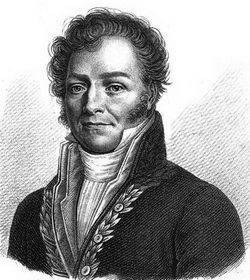 Out of habit, nodding to the audience, he quickly walked over to a long demonstration table and said something to the trainer old Lesho. Then, rising to the department, looked around at the students and quietly began:
Out of habit, nodding to the audience, he quickly walked over to a long demonstration table and said something to the trainer old Lesho. Then, rising to the department, looked around at the students and quietly began:- When a sailor shouts “Earth!” From the front mast of the frigate, and for the first time the captain sees an unknown shore through a telescope, this is a great moment in the life of a navigator. But isn't the moment just as great when the chemist first finds particles of a new, hitherto unknown substance at the bottom of the flask?
Tenar came down from the pulpit and walked over to the demonstration table, on which Lesho had already managed to put a simple device.
“Chemistry likes simplicity,” Tenar continued. - Remember this, gentlemen. There are only two glass vessels, external and internal. There is snow between them: a new substance prefers to appear at a low temperature. Diluted 6% sulfuric acid is poured into the inner vessel. Now it is almost as cold as snow. What happens if I throw a pinch of barium oxide into the acid? Sulfuric acid and barium oxide will give harmless water and a white precipitate - barium sulphate. Everyone knows that.
- But now I ask for attention! We are approaching unknown shores, and now from the front mast there will be a cry “Earth!” I’m not throwing oxide into acid, but barium peroxide, a substance that is produced when barium is burned with an excess of oxygen.
The audience was so quiet that the heavy breathing of a cold Lesho was clearly heard. Tenar, carefully stirring the acid with a glass rod, slowly, bit by bit, poured barium peroxide into the vessel.
“We will filter the precipitate, the usual barium sulphate,” said the professor, pouring water from the inner vessel into the flask.
- This substance is like water, isn't it? But this is strange water! I throw a piece of ordinary rust into it (Lesho, torch!), And watch the barely glowing flare. Water that supports burning!
- This is special water. It has twice as much oxygen as normal. Water is hydrogen oxide, and this liquid is hydrogen peroxide. But I like another name - “oxidized water”. And by the right of the discoverer, I prefer this name.
- When the navigator opens an unknown land, he already knows: someday cities will grow on it, roads will be laid. We chemists can never be sure of the fate of our discoveries. What awaits a new substance through the century? Perhaps the same widespread use as sulfuric or hydrochloric acid. And maybe complete oblivion - as unnecessary ...
The audience has rustled.
But Tenar continued:
- And yet I am confident in the great future of "oxidized water", because it contains a large amount of "life-giving air" - oxygen. And most importantly, it is very easy to stand out from such water. This alone instills confidence in the future of "oxidized water." Agriculture and crafts, medicine and manufacture, and I don’t even know where the “oxidized water” will be used! The fact that today still fits in the flask, tomorrow can powerfully break into every house.
Professor Tenar slowly descended from the pulpit.
Naive Parisian dreamer ... Convinced humanist, Tenar always believed that science should bring benefits to humanity, making life easier and making it easier and happier. Even constantly having before his eyes examples of the opposite nature, he piously believed in the great and peaceful future of his discovery. Sometimes you begin to believe in the justice of saying “Happiness is in ignorance” ...
However, the beginning of the career of hydrogen peroxide was quite peaceful. She regularly worked in textile factories, bleaching threads and linen; in laboratories, oxidizing organic molecules and helping to get new substances that do not exist in nature; she began to master the medical wards, confidently establishing herself as a local antiseptic.
But soon some negative aspects came to light, one of which turned out to be low stability: it could exist only in solutions of relatively low concentration. And as usual, once the concentration does not suit, it must be increased. And so it began ...
... and the find of engineer Walter
1934 year in European history was marked by quite a few events. Some of them excited hundreds of thousands of people, others passed quietly and imperceptibly. By the first, the term “Aryan science” in Germany can certainly be attributed. As for the second, it was the sudden disappearance from the open press of all references to hydrogen peroxide. The reasons for this strange loss became clear only after the crushing defeat of the "thousand-year Reich."
It all started with an idea that Helmut Walter, the owner of a small factory in Kiel for the production of precision instruments, research equipment and reagents for German institutes, had thought of. A man he was capable, erudite, and, importantly, enterprising. He noted that concentrated hydrogen peroxide can persist for quite a long time in the presence of even small amounts of stabilizing substances, such as, for example, phosphoric acid or its salts. Uric acid turned out to be a particularly effective stabilizer: 30 g of uric acid was sufficient to stabilize 1 L of a highly concentrated peroxide. But the introduction of other substances, decomposition catalysts, leads to the rapid decomposition of substances with the release of large amounts of oxygen. Thus, the tempting prospect of regulating the process of decomposition with rather inexpensive and simple chemicals was outlined.
In itself, all this has been known for a long time, but, in addition, Walter drew attention to the other side of the process. Peroxide decomposition reaction
the process is exothermic and is accompanied by the release of a fairly significant amount of energy - about 197 kJ of heat. This is a lot, so much that it is enough to bring to the boil two and a half times more water than is formed during the decomposition of the peroxide. It is not surprising that the whole mass instantly turned into a cloud of superheated gas. But this is a ready-made steam gas - the working fluid of turbines. If this superheated mixture is sent to the blades, then we will get an engine that can work anywhere, even where there is a chronically lack of air. For example, in a submarine ...
Kiel was the outpost of the German submarine shipbuilding, and the idea of an underwater engine for hydrogen peroxide captured Walter. She attracted her novelty, and besides, the engineer Walter was far from being a messy one. He was well aware that in the conditions of the fascist dictatorship the shortest path to prosperity was work for the military departments.
Already in 1933, Walter independently undertaken a study of the energy potential of solutions. Н2O2. He made a graph of the basic thermophysical characteristics of the solution concentration. And that's what I found out.
Solutions containing 40-65% Н2O2While decomposing, they noticeably heat up, but not enough to form a high-pressure gas. When decomposition of more concentrated solutions of heat is released much more: all the water evaporates without residue, and the residual energy is completely spent on heating the vapor gas. And what else is very important; each concentration corresponded to a strictly defined amount of heat generated. And a strictly defined amount of oxygen. And finally, the third - even stabilized hydrogen peroxide almost instantly decomposes under the action of potassium permanganates KMnO4 or calcium Ca (MnO4)2.
Walter was able to see a completely new field of application of a substance known for more than a hundred years. And studied this substance from the point of view of the intended use. When he brought his ideas to the highest military circles, he received an immediate order: to classify everything that is somehow connected with hydrogen peroxide. Henceforth, technical documentation and correspondence featured "aurol", "oxylin", "fuel T", but not generally known hydrogen peroxide.
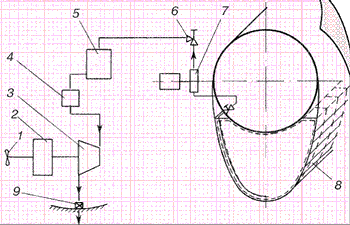
In 1936, Walter introduced the submarine leadership fleet the first installation, which worked on the indicated principle, which, despite the rather high temperature, was called “cold”. The compact and light turbine developed a power of 4000 hp at the stand, fully meeting the expectations of the designer.
The reaction products of the decomposition of a highly concentrated solution of hydrogen peroxide were fed into the turbine, which rotated the propeller through a reduction gearbox, and then were taken overboard.
Despite the obvious simplicity of such a solution, some problems arose (and where else without them!). For example, it was found that dust, rust, alkalis and other impurities are also catalysts and sharply (and much worse - unpredictable) accelerate the decomposition of the peroxide than they create the danger of an explosion. Therefore, elastic containers made of synthetic material were used for storing the peroxide solution. Such tanks were planned to be placed outside the robust hull, which made it possible to rationally use the free volumes of inter-shell space and, in addition, to create a peroxide solution support in front of the installation pump due to the pressure of the outboard water.
But another problem was much more difficult. The oxygen contained in the exhaust gas is rather poorly soluble in water, and treacherously betrayed the location of the boat, leaving a trace of bubbles on the surface. And this is despite the fact that "useless" gas is a vital substance for a ship designed to be at a depth as long as possible.
The idea of using oxygen as a source of oxidation of the fuel was so obvious that Walter took up the parallel design of the engine working on the “hot cycle”. In this embodiment, fossil fuel was supplied to the decomposition chamber, which burned in previously unused oxygen. The capacity of the installation increased sharply and, in addition, the consequence decreased, since the product of combustion — carbon dioxide — is much better than oxygen dissolved in water.
Walter was aware of the shortcomings of the “cold” process, but put up with them, since he understood that in a constructive way such a power plant would be disproportionately simpler than during the “hot” cycle, which means that you can build a boat much faster and demonstrate its merits .
In 1937, Walter reported the results of his experiments to the leadership of the German Navy and assured everyone of the possibility of creating submarines with combined-cycle turbine installations with a submerged speed of more than 20 nodes that had never been seen before. As a result of the meeting, it was decided to create an experimental submarine. In the course of its design, issues related not only to the use of an unusual power plant were solved.
Thus, the design speed of the underwater stroke made the previously used hull lines unacceptable. Here the aircraft manufacturers helped the sailors: several hull models were tested in a wind tunnel. In addition, dual steering wheels modeled on the Junkers-52 aircraft rudders were used to improve controllability.
In 1938, the world's first experimental submarine with a power plant for hydrogen peroxide with a displacement of 80 t, designated V-80, was laid in Kiel. The tests carried out in the 1940 year were literally stunned - a relatively simple and lightweight turbine with an 2000 horsepower. allowed the sub to develop the 28,1 node speed under water! True, it was necessary to pay for such an unprecedented speed with an insignificant cruising range: there was enough hydrogen peroxide reserves for a half to two hours.
For Germany during World War II, submarines were weapons strategic, because only with their help could cause significant damage to the economy of England. Therefore, already in 1941, the development and then construction of the V-300 submarine with a combined-cycle turbine operating in a “hot” cycle begins.
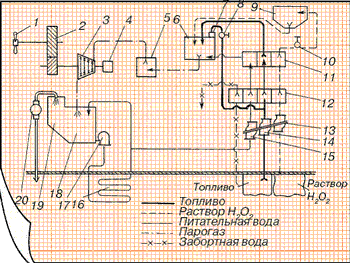
The boat V-300 (or U-791 - it received such a literal-digital designation) had two propulsion systems (more precisely, three): a gas turbine of Walter, a diesel engine, and electric motors. Such an unusual hybrid appeared as a result of the understanding that the turbine, in fact, is an afterburner. The high consumption of fuel components made it simply uneconomical to carry out long “idle” crossings or quiet “sneak up” to the enemy's ships. But it was simply indispensable for quickly leaving the position of attack, changing the place of attack, or other situations when it "smelled fried."
U-791 was never completed, and immediately laid four experimental combat submarines of two series - Wa-201 (Wa - Walter) and Wk-202 (Wk - Walter-Krupp) of various shipbuilding companies. In terms of their power plants, they were identical, but differed in fodder plumage and some elements of the cuttings and hull contours. From 1943, their trials began, which were difficult, but by the end of 1944. all major technical problems were behind. In particular, the U-792 (Wa-201 series) was tested at full cruise range, when, with a supply of 40 hydrogen peroxide, it went under the afterburner for almost four and a half hours and maintained the speed of the 19,5 node for four hours.
These figures so impressed the management of Kriegsmarine that, not waiting for the end of testing of experienced submarines, in January 1943 of the industry was issued an order to build the 12 ships of two series - XVIIB and XVIIG. With a displacement of 236 / 259 t, they had a diesel-electric unit with an output of 210 / 77 hp, which allowed them to move at speeds of 9 / 5 knots. In the case of combat necessity, two PSTUs with a total power of 5000 hp were turned on, which made it possible to develop an underwater stroke speed in 26 nodes.
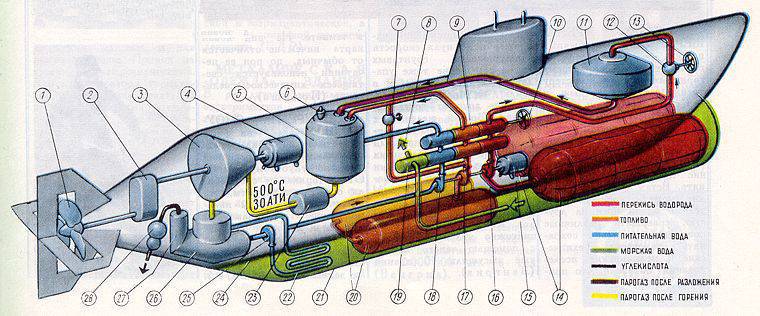
In short, the PSTU operation looks like this [10]. Using a three-step pump, diesel fuel, hydrogen peroxide and pure water were supplied through the 4-position regulator to feed the mixture into the combustion chamber; when the pump is running at 24000 rpm the mixture supply reached the following volumes: fuel - 1,845 cubic meters / hour, hydrogen peroxide - 9,5 cubic meters / hour, water - 15,85 cubic meters / hour. The above three components of the mixture were dispensed using the 4-positional regulator of the mixture supply in the weight ratio 1: 9: 10, which also regulated the 4 component — seawater, which compensates for the difference in the weight of hydrogen peroxide and water in the control chambers. The regulating elements of the 4-position regulator were driven by an HP 0,5 electric motor. and provided the required flow rate of the mixture.
After the 4-position regulator, hydrogen peroxide entered the catalytic decomposition chamber through openings in the lid of this device; on the sieve of which there was a catalyst - ceramic cubes or tubular granules about 1 cm long, impregnated with calcium permanganate solution. The steam gas was heated to a temperature of 485 degrees Celsius; 1 kg of catalyst elements passed up to 720 kg of hydrogen peroxide per hour at a pressure of 30 atmospheres.
After the chamber of decomposition, it entered the high-pressure combustion chamber made of strong hardened steel. The inlet channels were six nozzles, the side openings of which served for the passage of steam gas, and the central for fuel. The temperature in the upper part of the chamber reached 2000 degrees Celsius, and in the lower part of the chamber it dropped to 550-600 degrees by injecting clean water into the combustion chamber. The resulting gases were fed to the turbine, after which the exhaust gas-vapor mixture entered the condenser mounted on the turbine housing. With the help of a water cooling system, the temperature of the mixture at the outlet was lowered to 95 degrees Celsius, the condensate was collected in the condensate tank and entered into the sea water coolers using a condensate drainage pump, using flowing sea water for cooling while the boat was moving in a submerged position. As a result of passing through the refrigerators, the temperature of the produced water decreased from 95 to 35 degrees Celsius, and it returned through the pipeline as pure water for the combustion chamber. The remains of the gas-vapor mixture in the form of carbon dioxide and steam under pressure 6 atmospheres were taken from the condensate tank with a gas separator and removed overboard. Carbon dioxide relatively quickly dissolved in seawater, leaving no noticeable trace on the surface of the water.
As you can see, even in such a popular presentation, PGTU does not look like a simple device, which required the involvement of highly qualified engineers and workers for its construction. The construction of submarines with PGTU was conducted in an atmosphere of absolute secrecy. On ships allowed strictly limited circle of persons on the lists agreed in the highest instances of the Wehrmacht. At the checkpoints stood gendarmes disguised as firefighters ... In parallel, increased production capacity. If in 1939, Germany produced 6800 tons of hydrogen peroxide (in terms of 80% solution), then in 1944 - already 24 000 tons, and additional capacity was built on 90000 tons per year.
Not yet having full-fledged military submarines from the Perm State Technical University, having no experience of their combat use, Grand Admiral Doenitz was broadcasting:
Dönitz was echoed by the state commentator Fritsche. He was even more frank, promising the nation "a total submarine war with the participation of completely new submarines against which the enemy will be helpless."
I wonder if Karl Doenitz recalled these loud promises during those 10 years he had to while away in Spandau prison under the sentence of the Nuremberg Tribunal?
The final of these promising submarines was deplorable: for the whole time only 5 was built (according to other data, 11) boats from Walter State Technical University, of which only three were tested and were enlisted in the fleet. Not having a crew that did not make a single combat exit, they were flooded after the capitulation of Germany. Two of them, flooded in the shallow water area in the British occupation zone, were later lifted and shipped: U-1406 to the USA, and U-1407 to the UK. There, experts have carefully studied these submarines, and the British even conducted full-scale tests.
Nazi heritage in England ...
Walter's boats forwarded to England did not go for scrap. On the contrary, the bitter experience of both the past world wars at sea instilled in the British confidence in the absolute priority of anti-submarine forces. Among other things, the Admiralty considered the creation of a special anti-submarine submarine. They were supposed to be deployed on the approaches to the bases of the enemy, where they were to attack enemy submarines going to sea. But for this, the anti-submarine submarines themselves had to have two important qualities: the ability to secretly be under the enemy’s nose for a long time and at least briefly develop high speeds for quick rapprochement with the enemy and his sudden attack. And the Germans presented them a good start: RPD and gas turbine. The greatest attention was focused on PGTU, as a completely autonomous system, which, moreover, provided truly underwater speeds fantastic for that time.
German U-1407 was escorted to England by the German crew, who were warned about the death penalty in case of any sabotage. Helmut Walter was also delivered there. Restored U-1407 was enrolled in the Navy under the name "Meteorite". She served to 1949 g, after which she was removed from the fleet and dismantled for metal in 1950.
Later, in 1954-55. The British built two of the same type experimental submarines "Explorer" and "Excalibur" of their own design. However, the changes concerned only the external appearance and internal layout, as for the Perm State Technical University, it remained practically in its original form.

Both boats did not become the progenitors of something new in the English fleet. The only achievement is that the 25 underwater travel nodes received on the tests of the Explorer, which gave the British a reason to tell the whole world their priority on this world record. The price of this record was also record: permanent failures, problems, fires, explosions led to the fact that most of the time they spent at the docks and workshops in repair than in hikes and trials. And this is not counting the purely financial side: one running hour of “Explorer” cost pounds in 5000, which is equal to 12,5 kg of gold at the rate of that time. They were excluded from the fleet in 1962 (“Explorer”) and in 1965 (“Excalibur”) years with a deadly characteristic of one of the British submariners: “The best thing you can do with hydrogen peroxide is to interest potential adversaries in it!”
... and in the USSR]
The Soviet Union, unlike the allies, did not get the XXVI series boats, just as the technical documentation on these developments did not go: the "allies" remained true to themselves, once again hiding a tasty morsel. But the information, and quite extensive, about these failed novelties of Hitler in the USSR was available. Since Russian and Soviet chemists were always in the vanguard of world chemical science, the decision to study the possibilities of such an interesting engine on a purely chemical basis was made quickly. Intelligence agencies managed to find and assemble a group of German specialists who had previously worked in this field and expressed a desire to continue them on the former enemy. In particular, such a desire was expressed by one of Helmut Walter’s deputies, a certain Franz Statecki. Statezky and the group of "technical intelligence" for the export of military technology from Germany under the leadership of Admiral LA Korshunova, found in Germany the firm "Bruner-Kanis-Reider", which was an accessory in the manufacture of the turbine plants of Walter.
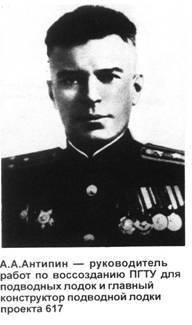 To copy the German submarine with the power plant of Walter, first in Germany and then in the USSR under the leadership of A.A. Antipin was created by the Antipin Bureau, an organization from which the efforts of the main designer of submarines (captain I rank AA Antipin) formed the LMBB Rubin and SPMB Malakhit.
To copy the German submarine with the power plant of Walter, first in Germany and then in the USSR under the leadership of A.A. Antipin was created by the Antipin Bureau, an organization from which the efforts of the main designer of submarines (captain I rank AA Antipin) formed the LMBB Rubin and SPMB Malakhit.The bureau's task was to study and reproduce the achievements of the Germans in new submarines (diesel, electric, steam and gas turbines), but the main task was to repeat the speeds of German submarines with the Walter cycle.
As a result of the work done, it was possible to completely restore the documentation, manufacture (partly from German, partly from newly manufactured units) and test the steam and gas turbine installation of German boats of the XXVI series.
After that, it was decided to build a Soviet submarine with the engine of Walter. Subject development of submarines with PSTU Walter called the project 617.
Alexander Tyklin, describing the biography of Antipin, wrote:
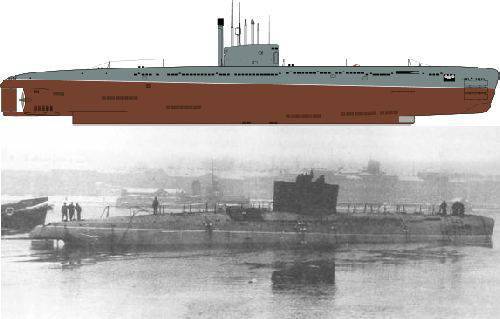
When designing the C-99 (this number received this boat), both the Soviet and foreign experience in creating single engines was taken into account. The pre-sketch project was completed at the end of 1947 of the year. The boat had 6 compartments, the turbine was located in an airtight and uninhabited 5 compartment, the PSTU control panel, a diesel generator and auxiliary mechanisms were mounted in 4, which also had special windows for monitoring the turbine. The fuel was 103 T of hydrogen peroxide, diesel fuel - 88,5 T and special fuel for the turbine - 13,9 T. All components were in special bags and tanks outside the robust hull. A novelty, in contrast to German and British developments, was the use of not manganese oxide MnO2 as a catalyst, not potassium permanganate (calcium). Being a solid, it was easily applied to the grids and grids, was not lost in the process, it took up much less space than the solutions and did not decompose with time. In all other respects, PSTU was a copy of the Walter engine.
The C-99 was considered as an explosive from the start. It worked out the solution of issues related to high underwater speed: the shape of the hull, controllability, stability of movement. The data accumulated during its operation made it possible to rationally design the first generation nuclear icebreakers.
In 1956 - 1958, large 643 project boats were designed with a surface displacement of 1865 tons and already with two PGTUs that were supposed to provide the boat with an underwater speed at the 22 node. However, in connection with the creation of the draft design of the first Soviet submarines with nuclear power plants, the project was closed. But the PSTU research on the C-99 boats did not stop, but were transferred to the mainstream to consider the possibility of using the Walter engine in the developed giant T-15 torpedo with atomic charge proposed by Sakharov for the destruction of naval bases and US ports. The T-15 was supposed to have a length of 24 m, an underwater course range up to 40-50 miles, and carry a thermonuclear warhead capable of causing an artificial tsunami to destroy US coastal cities. Fortunately, this project was also abandoned.
The danger of hydrogen peroxide did not fail to affect the Soviet Navy. 17 May 1959, an accident occurred on it - an explosion in the engine room. The boat miraculously did not die, but its restoration was considered inexpedient. The boat passed for scrap.
In the future, PSTU did not receive distribution in submarine shipbuilding either in the USSR or abroad. Advances in nuclear power have more successfully solved the problem of powerful submarine engines that do not require oxygen.
Information